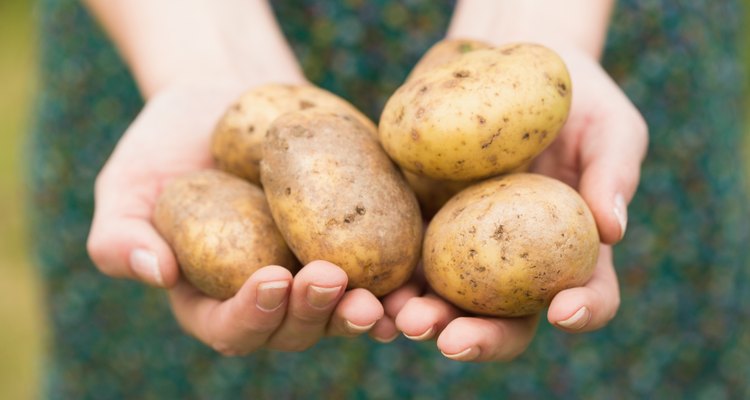
Wavebreakmedia Ltd/Wavebreak Media/Getty Images
There are brown, red, orange, yellow, gold and purple potatoes available in your local market. Additionally, you might also find a few green hued spuds. You may have eaten a few yourself and you might have heard they are not good for you. The green color is caused by chemical changes in the potato and while anything green is thought to be healthy and natural, a green potato is best avoided.
History
A potato is a tuber that normally grows underground. According to Drs Kuiper-Goodman and P.S. Nawrot of the Bureau of Chemical Safety, exposing a potato to light when it is developing is harmful. When an immature potato is exposed to light, it produces a chemical that makes its skin green. Solainine and chaconimine are two toxic chemicals produced by a potato when it is stressed. The chemicals are its defense against damaging light exposure, insects and disease.
Significance
Once a potato is exposed to light, its skin turns green due to an accumulation of chlorophyll. You might find that only the skin is green but sometimes the entire potato turns green. The amount of chlorophyll present is directly related to the amount of stress the potato has endured.
Considerations
Solainine and chaconimine help the potato protect itself from insect attack, mishandling during harvest and improper storage conditions. While a small amount of the potato stress chemicals are naturally found in the skin, eating a potato with a higher concentration can make you sick. If your potatoes are green, it indicates that they have been exposed to light which is a significant stressor.
Expert Insight
Unfortunately, exposing your potato to the many types of cooking and usual preparations, including microwaving will not reduce the toxicity of solainine and chaconimine. Solaine poisoning has been studied and is well documented in medical and clinical literature. When you eat only the flesh of the potato, you are less likely to be exposed to this toxic chemical. Solaine is found in higher concentrations in the potato skin.
Warning
Because green potato skins indicate a stressed potato, it is best to avoid eating the skin altogether. If the flesh of your potato is also green it is best to discard it. When you are shopping in the market, carefully examine a potato before you buy it and avoid any potatoes with green skin. If you become sick after eating a potato skin and your symptoms include fever, nausea and vomiting, abdominal cramps and diarrhea you may be suffering from solaine poisoning. Your symptoms will probably improve within a few hours, but if they persist call your health care provider.
Related Articles

How to Tell When Baking Potatoes Are Bad

Can You Bake a Potato That Already Has ...

What Is the Best Potato for Frying?

Can You Over-Bake a Potato?

The Calories in Jacket Potatoes With ...

Does Stainless Steel Jewelry Turn Green?

Are Bell Peppers Nightshade Vegetables?

Why Do You Need to Pierce Potatoes ...

Side Effects of Certain Dri

Can You Store Potatoes in the ...

Skin Rashes Caused From Tanning Beds

How to Cut Baked Potatoes

Health Benefits of Potatoes, Onions and ...

How to Store Potatoes for the Long Term

How Many Calories in a Baked Potato ...

Is Eating a Banana With Brown Spots Bad ...

How Does Ultraviolet Light Affect ...

How to Cook Small Dutch Yellow Potatoes

How to Cook Potatoes for Eight Hours in ...

Phototherapy Vs. Tanning Bed
References
Photo Credits
Wavebreakmedia Ltd/Wavebreak Media/Getty Images